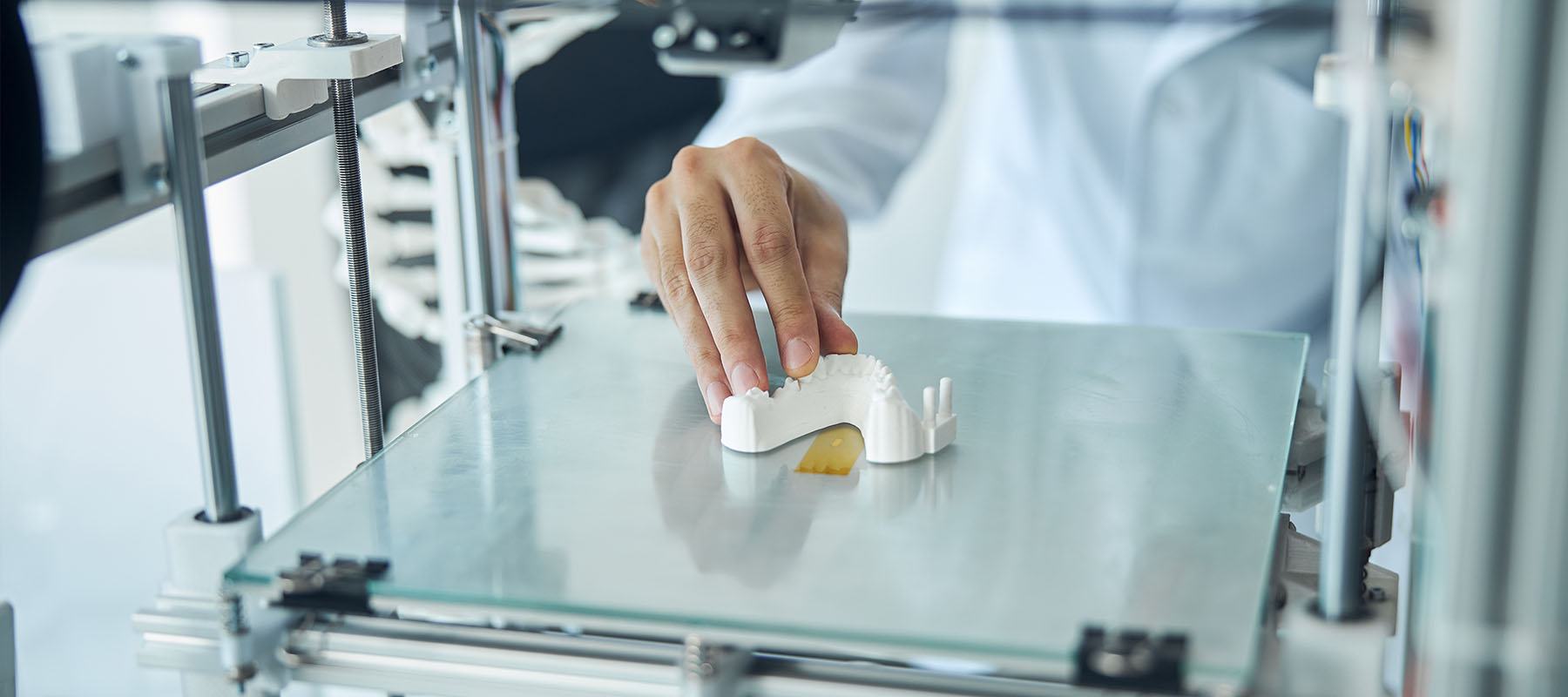
Thanks to advances in technology, dental care today is more precise, gentle, and convenient than ever before. With a chairside 3D printer, our office can fabricate aesthetically pleasing and long-lasting restorations in just a single visit! Compatible with optical scanning and integrated software systems, our 3D printer receives the exact specs of the patient’s prepared tooth and uses this information to mill a precision-fitting ceramic restoration while the patient waits. By eliminating waiting time and the need for a temporary restoration, our 3D printer maximizes procedure comfort and efficiency to benefit a patient’s overall dental experience.

Dental 3D printing is an additive manufacturing process that builds dental appliances and restorations layer by layer from digital designs. It uses files generated by intraoral scanners, CBCT systems, or dental design software to produce highly accurate objects. This technology enables creation of crowns, bridges, surgical guides, and other custom devices with controlled geometry and repeatable results.
Unlike traditional subtractive methods that remove material, 3D printing adds precise amounts of biocompatible resin or ceramic to achieve the final shape. The digital workflow reduces manual steps and improves traceability from scan to final restoration. As a result, clinicians can achieve consistent quality across a variety of restorative and surgical applications.
Chairside 3D printing begins with a digital scan of the prepared tooth or treatment area, which produces an exact 3D model of the patient’s anatomy. That digital model is imported into design software to create the restoration or guide, and the finalized file is sent directly to an in-office printer. The printer builds the restoration in successive layers while the patient waits, allowing the clinician to finish and place the appliance within the same appointment.
The in-office workflow eliminates the need for temporary restorations and external lab shipping, streamlining the clinical process. Post-processing steps such as cleaning, curing, and polishing are performed immediately to ensure optimal fit and aesthetics. This integrated approach enhances efficiency and helps maintain continuity between the chairside scan and the final restoration.
3D printing supports a wide range of dental items, including provisional and final crowns, multi-unit bridges, implant surgical guides, occlusal splints, and orthodontic models. It is also used for custom trays, provisional veneers, and certain denture components depending on the materials available. The versatility of the technology allows clinicians to select appropriate applications based on clinical requirements and material properties.
Some restorative workflows combine printed substructures with milled ceramic or layered composite to meet aesthetic and strength goals. For implant cases, printed surgical guides improve implant placement accuracy by translating the digital plan to the operative field. As material science continues to evolve, the portfolio of printable dental devices keeps expanding.
Precision in 3D printing starts with accurate digital impressions captured by intraoral scanners, which record the exact contours and margins of prepared teeth. The print process then follows the digital design closely, producing restorations with consistent dimensions and tight tolerances. This digital-to-physical translation reduces manual lab variability that can affect fit and occlusion.
Advanced printers and calibration protocols minimize dimensional distortion, and post-processing steps help achieve the final surface finish and seating accuracy. When combined with quality design practices and verification on the model or in the mouth, printed restorations can deliver excellent marginal adaptation and occlusal harmony. Ongoing quality control at each step is essential to maintain those predictable outcomes.
3D printing is most effective when integrated into a fully digital workflow that begins with intraoral scanning or CBCT imaging. Scans provide the surface geometry needed to design crowns and guides, while CBCT offers three-dimensional information about bone and anatomical landmarks for implant planning. These data sources can be merged in planning software to create surgical guides or restorations that reflect both hard- and soft-tissue anatomy.
The digital files are exported in standard formats and prepared for printing using slicing software that translates models into printable layers. Integration between scanner, planning software, and printer reduces data transfer errors and supports efficient clinical decision-making. Proper calibration and software compatibility are important to maintain the fidelity of the combined datasets.
By enabling same-day fabrication of restorations and appliances, chairside 3D printing can substantially reduce the number of appointments a patient needs to complete treatment. Eliminating temporary restorations and extra lab visits helps minimize time spent in transition and reduces the potential for fit-related follow-ups. Patients typically experience fewer impressions and less overall treatment time when the digital workflow is used effectively.
Many patients also report greater convenience and satisfaction from receiving final restorations in a single visit, which can reduce anxiety associated with prolonged treatment. The accurate fit and reduced need for adjustments contribute to a smoother clinical encounter. Clinicians should still allow time for intraoral verification, occlusal adjustment, and patient education during the visit.
Dental 3D printers use a variety of biocompatible materials, including photopolymer resins formulated for provisional and long-term restorations, surgical guide resins, and high-strength composite or ceramic-like materials. Material selection depends on the intended use, required strength, aesthetic demands, and compatibility with the particular printer and post‑curing process. Manufacturers provide specifications and indications that guide clinicians in choosing appropriate materials for clinical cases.
For applications requiring higher strength or specific wear characteristics, printed parts may be combined with milled ceramics or layered with veneering materials. Surgical guides typically use rigid, sterilizable resins to maintain drilling accuracy during implant placement. Proper handling, curing, and verification of material properties are essential to ensure safe and predictable clinical performance.
The longevity of 3D-printed restorations depends on material properties, the design of the restoration, occlusal forces, and the clinical technique used during fabrication and placement. Some modern printable materials are suitable for long-term provisional use and specific permanent restorations when processed and finished correctly. Durability can approach that of conventional restorations in appropriate indications, but clinicians must evaluate each case individually.
Regular follow-up and proper oral hygiene are important to monitor the performance of printed restorations over time. Where maximum strength and longevity are required, clinicians may select hybrid workflows that incorporate milled ceramics or traditional lab-fabricated components. Documentation of material selection and post-processing steps helps support predictable outcomes and facilitates future maintenance.
While 3D printing is a powerful tool, it is not universally appropriate for every clinical situation. Cases requiring large-scale full-arch prosthetics, certain high-load posterior restorations, or materials not supported by the in-office printer may be better served by traditional laboratory methods or mixed digital workflows. Complex aesthetic demands may also call for laboratory-grade layering and staining techniques that are not always replicated with chairside materials.
Clinical judgment is essential to determine when a printed solution meets the functional, aesthetic, and biocompatibility requirements of the patient. In cases where printed materials or printers do not meet the case specifications, collaborating with a dental laboratory or using alternative manufacturing methods ensures the best patient outcome. Clear communication with patients about expected results and maintenance is also important.
Patients should arrive with any recent dental records or x-rays if available, and inform the team about medical conditions, medications, and known material sensitivities. The clinical appointment typically begins with a focused examination and digital scanning, so patients should be prepared for intraoral scanning rather than conventional impression trays. Good oral hygiene before the visit helps ensure accurate scans and predictable restorative outcomes.
At Fay Hu General Dentistry in Winter Park, FL, our team will explain the scanning and printing workflow and answer questions about the expected timeline and post-placement care. Patients can expect brief verification steps such as fitting, occlusal adjustment, and polishing before leaving the office with their final or provisional restoration. Clear aftercare instructions will be provided to support long-term success and to schedule any necessary follow-up visits.

We are dedicated to providing the highest quality of dental care to our patients.
Through excellence in dentistry and quality in relationships, we strive to positively impact your oral health, aesthetics, and self-esteem. From the front desk to the treatment room, our experienced team is here to support you with expert care and genuine compassion.